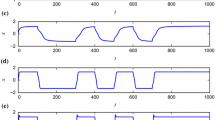Abstract
The output effect of fractional-order stochastic resonance (FOSR) system is affected by many factors such as input system parameters and noise intensity. In practice, many tests are needed to adjust parameters to achieve the optimal effect, and this way of “trial and error” greatly limits the application prospect of FOSR. Based on genetic algorithm, a suitable adaptive function was established to adjust the multiple parameters, including the fractional order, system parameters, and the input noise intensity of the fractional bistable system. Simulation results showed that the algorithm can achieve joint optimization of these parameters. It was proved that this algorithm is conducive to the real-time adaptive adjustment of the FOSR system in practical applications and conducive to the application and extension of FOSR in weak signal detection and other fields. The proposed algorithm has certain practical value.
















Similar content being viewed by others
References
Benzi R, Parisi G, Sutera A (1982) Stochastic resonance in climatic change. Tellus 34(1):10–16
Zhou T, Moss F (1990) Analog simulations of stochastic resonance. Phys Rev A 41(8):4255
Gammaitoni L, Marchesoni F, Menichella-Saetta E (1989) Stochastic resonance in bistable systems. Phys Rev Lett 62(62):349–352
Fauve S, Heslot F (1983) Stochastic resonance in a bistable system. Phys Lett A 97(1):5–7
Kou SC, Xie XS (2004) Generalized Langevin equation with fractional Gaussian noise: subdiffusion within a single protein molecule. Phys Rev Lett 93(18):180603
Weina Z, Lin M (2013) Weak signal intelligent detection system based on stochastic resonance and artificial fish swarm algorithm. Chin J Sci Instrum 34(11):2464–2470
Magin RL, Abdullah O, Baleanu D (2008) Anomalous diffusion expressed through fractional order differential operators in the Bloch–Torrey equation. J Magn Reson 190(2):255–270
Kocaoglu M (2014) Stochastic resonance in graphene bilayer optical nanoreceivers. IEEE Trans Nanotechnol 13(6):1107–1117
Herrmann S, Imkeller P, Pavlyukevich I (2014) Stochastic resonance: a mathematical approach in the small noise limit, vol 194. American Mathematical Society, Providence, p 189
Litak G, Borowiec M (2014) On simulation of a bistable system with fractional damping in the presence of stochastic coherence resonance. Nonlinear Dyn 77(77):681–686
Zheng R, Nakano K, Hu H (2014) An application of stochastic resonance for energy harvesting in a bistable vibrating system. J Sound Vib 333(12):2568–2587
Sun Q, Liu H, Nan H (2015) Nonlinear restoration of pulse and high noisy images via stochastic resonance. Sci Rep 5(4):1–6
Bito J, Jeong S, Tentzeris MM (2016) A real-time electrically controlled active matching circuit utilizing genetic algorithms for wireless power transfer to biomedical implants. IEEE Trans Microw Theory 64(2):365–374
Jung P, HaoNggi P (2017) Amplification of small signals via stochastic resonance. Phys Rev A 44(12):8032–8042
Yang JH, Sanjuán MAF, Liu HG (2016) Stochastic P-bifurcation and stochastic resonance in a noisy bistable fractional-order system. Commun Nonlinear Sci Numer Simul 41:104–117
Liu L, Zheng L, Zhang X (2016) Fractional anomalous diffusion with Cattaneo–Christov flux effects in a comb-like structure. Appl Math Model 40(13–14):6663–6675
Wang W, Yan Z, Liu X (2017) The escape problem and stochastic resonance in a bistable system driven by fractional Gaussian noise. Phys Lett A 381(29):2324–2336
He P, Dai S (2014) Stealth real-time paths planning for heterogeneous UAV formation based on parallel niche genetic algorithm. J Comput Inf Syst 10(15):6731–6740
Coury DV, Silva RPM, Delbem ACB (2014) Programmable logic design of a compact Genetic Algorithm for phasor estimation in real-time. Electric Power Syst Res 107(2):109–118
Acknowledgements
This project is supported by National Natural Science Foundation of China (Grant No. 51775530) and National Science and Technology Major Project of the Ministry of Science and Technology of China (Grant No. 2015ZX02101).
Author information
Authors and Affiliations
Corresponding author
Additional information
Publisher's Note
Springer Nature remains neutral with regard to jurisdictional claims in published maps and institutional affiliations.
Rights and permissions
About this article
Cite this article
Zheng, Y., Huang, M., Lu, Y. et al. Fractional stochastic resonance multi-parameter adaptive optimization algorithm based on genetic algorithm. Neural Comput & Applic 32, 16807–16818 (2020). https://doi.org/10.1007/s00521-018-3910-6
Received:
Accepted:
Published:
Issue Date:
DOI: https://doi.org/10.1007/s00521-018-3910-6




